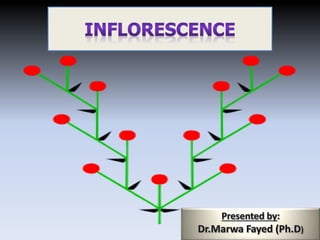Report
Share

Recommended
Recommended
More Related Content
What's hot
What's hot (20)
Vascular Cambium & Seasonal activity & its Role in Stem & Root

Vascular Cambium & Seasonal activity & its Role in Stem & Root
Morphology of flowering plants - I (root, stem & leaf)

Morphology of flowering plants - I (root, stem & leaf)
Inflorescence Types,cymose and racemose types,examples with Diagrams 

Inflorescence Types,cymose and racemose types,examples with Diagrams
Similar to Inflorescence
Similar to Inflorescence (20)
More from Marwa A.A. Fayed
More from Marwa A.A. Fayed (20)
Recently uploaded
https://app.box.com/s/7hlvjxjalkrik7fb082xx3jk7xd7liz3TỔNG ÔN TẬP THI VÀO LỚP 10 MÔN TIẾNG ANH NĂM HỌC 2023 - 2024 CÓ ĐÁP ÁN (NGỮ Â...

TỔNG ÔN TẬP THI VÀO LỚP 10 MÔN TIẾNG ANH NĂM HỌC 2023 - 2024 CÓ ĐÁP ÁN (NGỮ Â...Nguyen Thanh Tu Collection
Recently uploaded (20)
Basic Civil Engineering first year Notes- Chapter 4 Building.pptx

Basic Civil Engineering first year Notes- Chapter 4 Building.pptx
Food safety_Challenges food safety laboratories_.pdf

Food safety_Challenges food safety laboratories_.pdf
Kodo Millet PPT made by Ghanshyam bairwa college of Agriculture kumher bhara...

Kodo Millet PPT made by Ghanshyam bairwa college of Agriculture kumher bhara...
On National Teacher Day, meet the 2024-25 Kenan Fellows

On National Teacher Day, meet the 2024-25 Kenan Fellows
Interdisciplinary_Insights_Data_Collection_Methods.pptx

Interdisciplinary_Insights_Data_Collection_Methods.pptx
UGC NET Paper 1 Mathematical Reasoning & Aptitude.pdf

UGC NET Paper 1 Mathematical Reasoning & Aptitude.pdf
Unit-V; Pricing (Pharma Marketing Management).pptx

Unit-V; Pricing (Pharma Marketing Management).pptx
HMCS Vancouver Pre-Deployment Brief - May 2024 (Web Version).pptx

HMCS Vancouver Pre-Deployment Brief - May 2024 (Web Version).pptx
TỔNG ÔN TẬP THI VÀO LỚP 10 MÔN TIẾNG ANH NĂM HỌC 2023 - 2024 CÓ ĐÁP ÁN (NGỮ Â...

TỔNG ÔN TẬP THI VÀO LỚP 10 MÔN TIẾNG ANH NĂM HỌC 2023 - 2024 CÓ ĐÁP ÁN (NGỮ Â...
Inflorescence
- 2. Inflorescence • Definition: It is the aggregation of the flowers on the plant. • Kinds of inflorescence: (According to the mode of branching) I- Racemose inflorescence. II- Cymose inflorescence. III- Mixed inflorescence.
- 3. Inflorescence - Indefinite. - Monopodial branching. - Youngest flower at the apex or at the centre. - Oldest flowers at the base or to the outside. 1- Racemose Inflorescence 2- Cymose Inflorescence - Definite. - Sympodial branching. - Youngest flower near the base or to the outside.
- 5. 1- Racemose Inflorescence I- Simple Racemose Inflorescence II- Compound Racemose Inflorescence 1- Raceme 2- Corymb 3- Umbel 4- Capitulum 5- Spike 6- Spadix 7- Catkin 8- Strobile 1-Panicle 2-Compound Corymb 3- Compound Umbel 4-Compound capitulum 5- Compound Spike 6- Compound Spadix
- 6. I. Simple Racemose Inflorescence 1. Raceme: • with elongated axis carrying pedicellate flowers (pedicels of equal lengths e.g. Lobelia).
- 7. 2. Corymb: • with elongated axis carrying pedicellate flowers (pedicels of different lengths, e.g. F: Cruciferae.
- 8. 3. Umbel: • with very short axis carrying pedicellate flowers (pedicels of equal lengths are radiating), e.g F: Umbelliferae.
- 10. 4. Capitulum (= flower head) • It is a racemose inflorescence having very short swollen flattened axis and on which are inserted sessile flowers. • It is encircled by involucre consisting of bracts, the flowers are generally small and called florets.
- 11. • There are two types of florets inserted on the same capitulum: • The central which have tubular corolla and called tubular or disc florets. • The marginal which have strap-like corolla and called ligulate or ray florets.
- 12. 5. Spike: • with elongated axis carrying nearly sessile florets, e.g Plantago.
- 13. 6. Spadix : • with elongated, thick and fleshy axis carrying sessile florets usually unisexual flowers, e.g. F: Acarus.
- 14. 7. Catkin: • pendulus axis carrying sessile florets of unisexual type either male or female, e.g F:Fagaceae.
- 15. 8. Strobile: • A spike with large membranous scales (bract or bracteoles), as in Humulus.
- 16. • II. Compound Racemose Inforescence 1. Panicle: a compound raceme consisting of racemes arranged in racemose manner e.g Eguevia
- 17. 2. Compound Corymb: as in F: Cruciferae. Corymb Compound Corymb
- 18. 3. Compound Umbel: as in F: Umbelliferae.
- 19. 4- Compound Spike: as in Wheat.
- 20. 5- Compound Capitulum: as in F: Composiate.
- 21. 6- Compound Spadix: as in Palm.
- 22. II- Cymose inflorescence • Cymose inflorescence is characterized by the sympodial branching with the oldest flowers present on the top of the elongated pedicel or occupied in the central position of the flat receptacle. The primary axis and the daughter branches end in a flower i.e. growth of the axis is limited by the formation of a flower. • Cymose inflorescence may be either simple or compound.
- 23. 1- Simple Cyme: The main axis terminate in a flower and one, two or more stalked flower arises on its pedicel, thus resemble the simple umbel but differ from the umbel in that the oldest flower is present in the centre.
- 24. 2- Compound Cymose • In which the lateral branches continue to give further branches. It may be: 1- Monochasium (or one sided cyme): where the main axis terminate in a flower, the pedicel of which posses two bracteoles, one of which develop one branch from the bud in its axil and so on. There are two kinds: a- Helicoid cyme: produced as a development of the bud of only one side (either right or left e.g. Juncus). b- Scorpoid cyme: produced as a development of the bud of two sides (right and left) alternatively, e.g Iris.
- 26. III- Mixed Inflorescence When both racemose and cymose types of branching occur on the same inflorescence.
